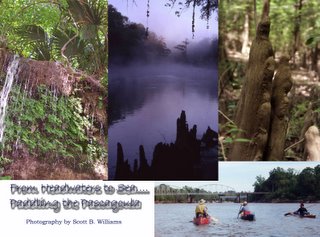Buddy advises not to be content with workaday world
I’m mad at Scott Williams.
Just when I’d gotten comfortable being an office flunky, my nose to the newspaper grindstone, my longtime camping buddy comes along with a book advising the opposite: Get outdoors, have adventures, break free!
Gee, thanks, pal.
Scott, who divides his time between Jackson and the Coast, has written and published a little book called “Astray of the Herd: Observations, Commentaries and Rants from Outside the Mainstream.” The book is a precursor to “On Island Time,” to be released this spring by University Press of Mississippi, about Scott’s epic sea kayaking voyage across the Caribbean.
While “On Island Time” will describe the journey, “Astray of the Herd” relates the philosophies Scott developed along the way. And they are not particularly comforting to us workaday folks.
“The only way to slow down the clock and claim a chunk of rapidly passing time is to exit the herd as I did and return to a simpler life in pace with the rhythms of Nature,” Scott asserts. “My kayak trip was an indulgence in time far beyond the experience of anyone running with the herd.”
Scott, you see, hasn’t held a “real” job since he abandoned his career as an electrical engineering technician as a young man to seek adventure. Since then, when not kayaking or sailing, he works as a self-employed carpenter, boatwright and free-lance writer.While he works hard, his schedule allows him to take off on trips when he gets the urge. He’s now 42 and apparently has no regrets.
“Many of those who put aside life in the present in favor of earning a secure retirement will, by the time they finally get to leave their job, be too sick or otherwise physically unfit to do anything fun,” he claims. “At this point in time they might wish they had lived differently, but it will then be too late.”
For a variety of reasons — the death of my mother last September, then having to put my stepdad into assisted living, and toiling on the Enterprise-Journal Perspective edition from January through March — I’ve scarcely ventured into the outdoors in forever.
Other than a single day trip down the Bogue Chitto with some church friends, I haven’t canoed, much less camped, since floating the Pascagoula River last April. Haven’t even thought about it, much. Too busy with other things. Then Scott hands me a copy of his book. And it stirs memories of what it feels like to strike out into the unknown with pack on back or paddle in hand. Here’s what he writes of his kayak explorations in Samana Bay, Dominican Republic:
“I followed the north shore of the bay for several miles, paddling past limestone cliffs that were overgrown in tropical vegetation. The landscape here was much greener than in the Bahamas, and water flowed in cascades from mountain streams emptying into the bay. Much of the coastline was too rugged for landing my sea kayak. At the far end of the estuary, mangrove jungle separated the open bay from any dry land, and I paddled through tunnels of overhanging branches that shut out the sunlight and cast dark shadows over secret waterways.”
Hey, thanks, Scott. As if I needed these fanciful images to distract me. Don’t you know I’ve got work to do, cares to fret over? And yet, there has been a touch of spring in the air, flowers blooming among the pines — a perfect time to slide a boat into the water....
“Astray of the Herd” (softcover, 168 pages) is available for $12 at
www.scottbwilliams.com.












